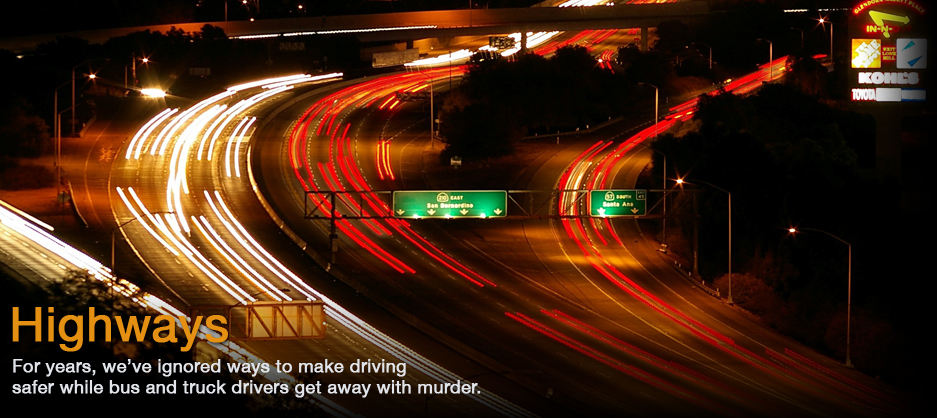Safety officials seek ways to stop highway accidents
Published on Jan. 18, 2012
On Nov. 23, 2007, Kate Zoromski, 16, was traveling south on Interstate 43 to her home in Grafton, Wis., when her car drifted out of the travel lane and into the median.
A cable barrier was in place to stop the vehicle, but it slipped underneath into oncoming traffic. The car collided with an SUV, killing Zoromski and one of her friends instantly. A third person died a week later from head injuries sustained in the crash.
U.S. traffic fatalities have been dropping steadily over the past decade, according to the National Highway Traffic Safety Administration, but the numbers are still staggering: More than 32,700 people died in traffic accidents in 2010. Many of them were young.
In fact, motor vehicle accidents are the leading cause of accidental death for Americans under the age of 34 and the 10th leading cause of death for all ages, according to the Centers for Disease Control and Prevention.
Safety engineers are doing what they can to change those statistics, using three very different engineering solutions that alert drivers to danger, slow down traffic and physically impede vehicles from leaving the roadway. All three have been shown to reduce the likelihood of accidents, but as Kate Zoromski’s family discovered, they do not always prevent them.
Rumble Strips
One of the most nagging safety problems is on rural highways, partly due to the sheer number of them and partly because of engineering.
Many narrow two-lane highways were engineered decades ago, and are substandard by today’s standards. Tight, frequent turns, higher speed limits, wildlife crossing roads and fatigue all make rural roads more dangerous than modern urban highways, according to the National Highway Transportation Safety Administration.
Exactly how dangerous is open to interpretation, but official estimates put the level of danger on rural roads as double to triple that of urban roads.
In 2005, NHTSA reported that the rural fatality rate was triple the urban fatality rate on roads. The U.S. Census estimates that from 2000 to 2009, rural traffic deaths accounted for 57 percent of total traffic fatalities, according to federal crash data – a far greater proportion than the 23 percent of the country’s population that lives in rural areas.
Driving habits are partly to blame. Safety experts agree that people tend to drive differently on rural roads than urban ones.
Urban roads carry more lanes and traffic, honing the drivers’ senses because there are more things happening around them, said Insurance Institute for Highway Safety vice president Russ Rader. Rural roads typically are less busy but aren’t as straight, and drivers may not be as alert.
“Rural roads lull drivers into a false sense of complacency because they are monotonous and can stretch in one direction for long periods of time with little to no traffic,” Rader said. “Drivers feel like they are safe because of how inactive the roadway is, and they lower their guard.”
To make rural roads safer, highway engineers began putting in rumble strips beginning in 1952. A machine cuts notches, or rumble strips, into the pavement that send an unmistakable shudder through a vehicle that is straying from the travel lane.
Rumble strips are cost effective and require no major reconstruction of the road. The Texas Transportation Institute found rumble strips cost about 25 cents per foot to install.
And they seem to be effective, cutting in half the number of crashes in which a vehicle drifts onto the shoulder, the Texas Institute found. When the notches are cut in the middle of a two-lane or four-lane highway with no median present, crossover crashes fall 30 percent to 40 percent, according to the Federal Highway Administration.
“Rumble strips are a good treatment for rural highways where redesigning an entire stretch of highway is too expensive,” said Ray Krammes, a senior highway research engineer with the Federal Highway Administration, an agency within the U.S. Department of Transportation that supports state and local governments in the design, construction and maintenance of highways.
Roundabouts
If rumble strips are the low-cost workhorse engineering treatment for rural highways, roundabouts are the boutique innovation for cities.
In cities, crashes are more attributable to dense traffic so safety solutions tend to focus on ways to control traffic. Roundabouts are one such method.
A type of circular junction in which traffic travels in one direction around a central island as vehicles enter and exit, roundabouts have been widely used in Europe, where they are hailed as effective in reducing traffic accident. They are beginning to gain traction in the U.S.
At first, small roundabouts began cropping up in residential areas as an alternative to speed humps. Then, they began replacing big intersections with traffic lights; they are now being introduced on freeway interchanges.
Ten years ago, there were roughly 50 roundabouts in the nation. Today, there are more than 2,000. Converting a two-way stop, four-way stop or signalized intersection to a roundabout reduces fatalities by 75 percent and overall injury by 30 percent, the Federal Highway Administration says.
That’s because roundabouts slow traffic to a speed where deadly collisions are less likely. Collisions typically occur on the rear or side of vehicles and when cars waiting for traffic move slower than 25 mph, Krammes said.
So rather than high-speed T-bone crashes at traffic lights, officials settle for more common fender-bender accidents. They may cause a body-shop bill, but rarely cost a human life.
A two-lane roundabout costs roughly $330,000, while a typical intersection with traffic signals and turn lanes costs about $450,000, according to a study done by the Washington State Department of Transportation. Additionally, roundabouts do not require electrical maintenance that signalized intersections do.


 In No Shape to Drive
In No Shape to Drive